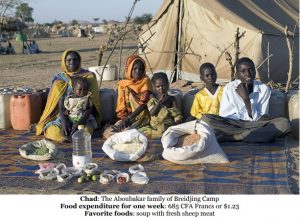

In Peter Menzel and Faith D’Alusio’s Hungry Planet: What the World Eats, through the medium of photographs, rich stories of many cultures surface as well as contrasting themes of economic access to nutrition and/or lack of dietary variety is immediately apparent. The photos not only provide a glimpse into the food culture of different countries but also a look at environment and socioeconomic factors that play a part in providing food. When considering the Western diet, Michael Pollan states “…main features of the Western diet: lots of processed foods and meat, lots of added fat and sugar, lots of everything except fruits, vegetables, and whole grains.” (Pollan, Pg. 89.) The photo of the Revis family in North Carolina depicts the Western diet very well. In contrast, the diet of many people living in developing countries may consist of more whole foods and less sugar, but they also lack the access to variety that the western society has. As we see in the photo of the Aboubakar family of Breidjing Camp in Chad, the family’s main diet consists of grains and a very limited quantity of fruits, vegetables and protein. The food purchased by the Revis family in North Carolina is covered in many plastic packages while the food of the Aboudakar family in Chad is held in burlap sacks. We can see that each family has children. While the processed foods in the Western diet are unhealthy, the Revis family appears to have the financial ability to provide their children with the appropriate amounts of food and nutrition for their developmental needs. Unlike the Aboudakar family, who’s food is most likely rationed, developmental needs of children cannot always be prioritized. The little food they have must feed the entire family. Menzel’s photo of a young girl preparing pot of porridge that her family will eat for the entirety of the day, accurately depicts what Michael Carolan describes as “Hidden hunger”—a form of malnutrition. While the Aboubakar family may eat three meals a day, the consistent lack of nutritional diversity in diet can cause profound damage to the body and developmental issues in children. “Children are particularly sensitive population to micronutrient malnutrition due to having higher nutritional requirements per kilogram of body weight. Almost two thirds of all deaths of children globally are attributed to nutritional deficiencies (Caballero, 2002, pp3-4).” (Carolan, pg.63).

